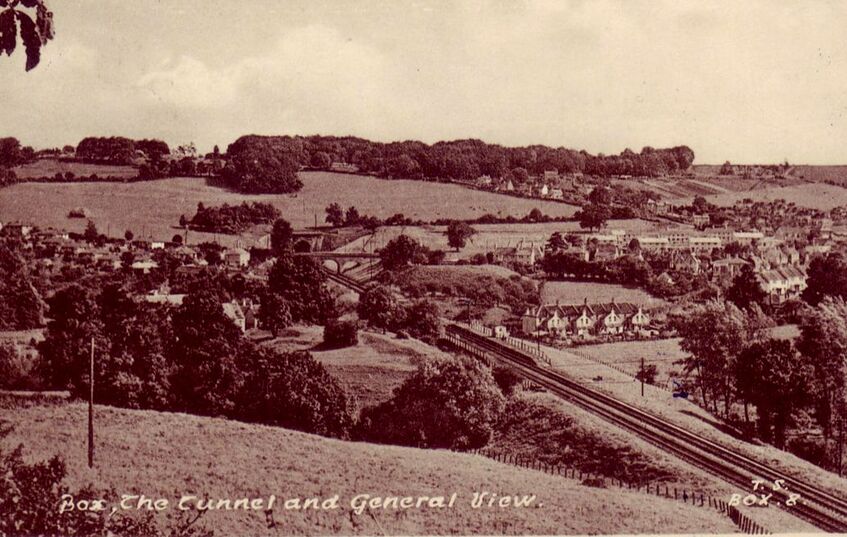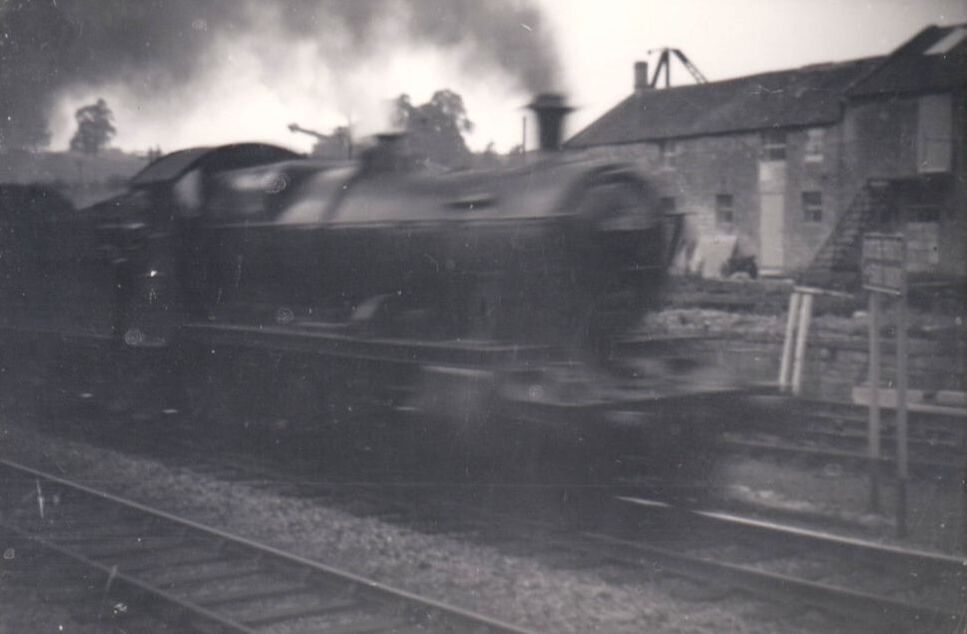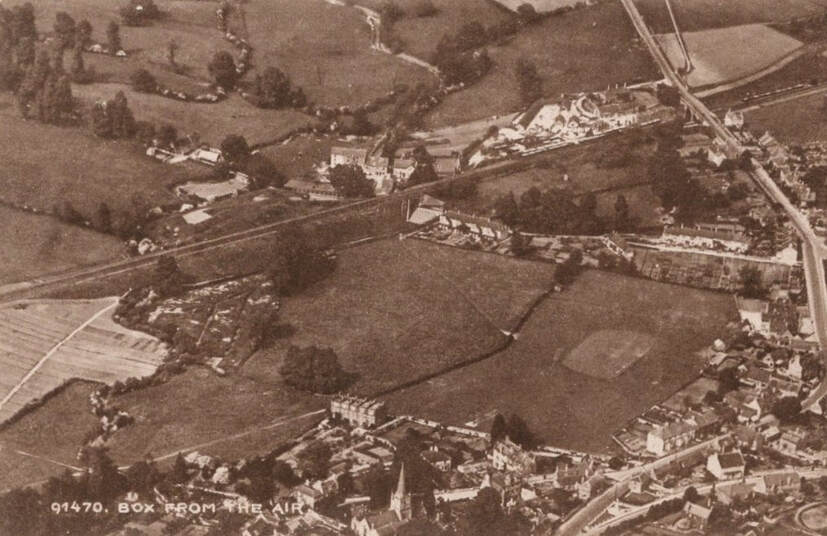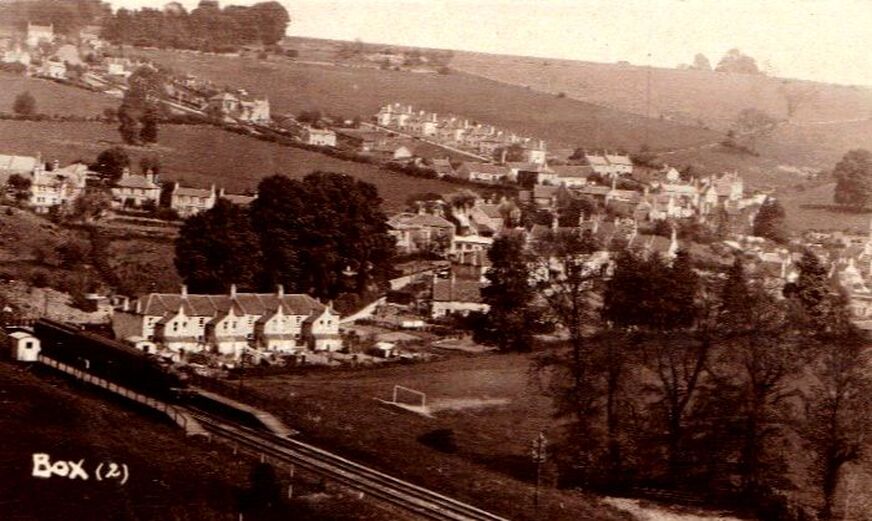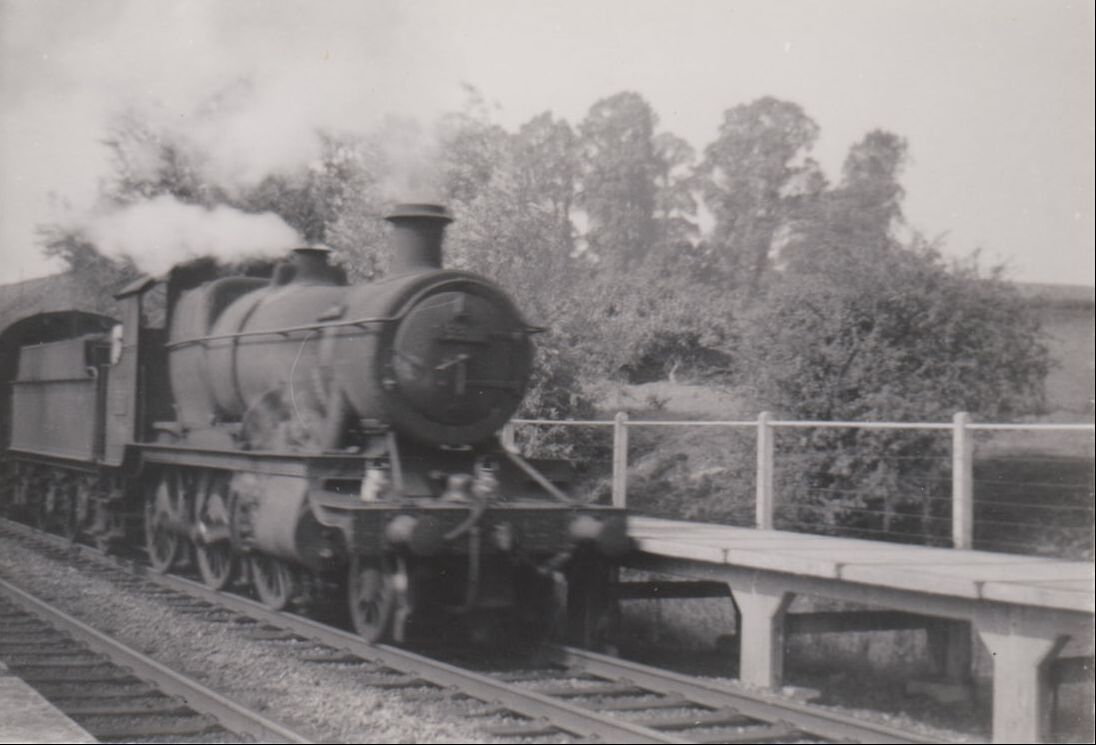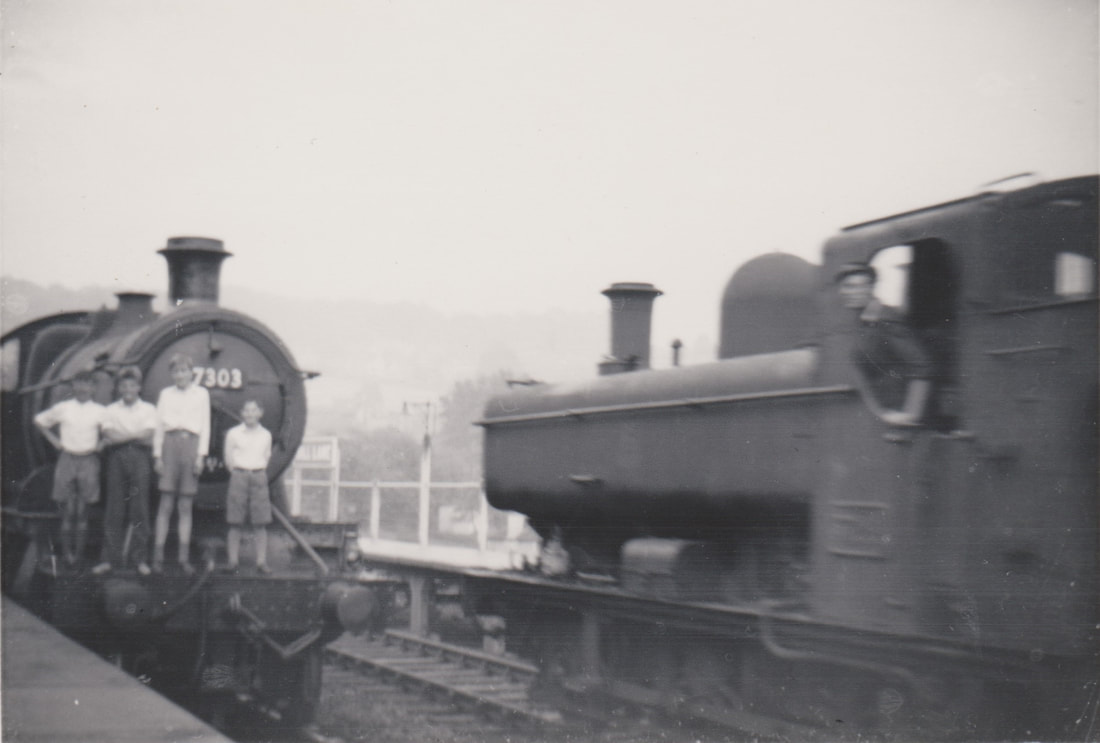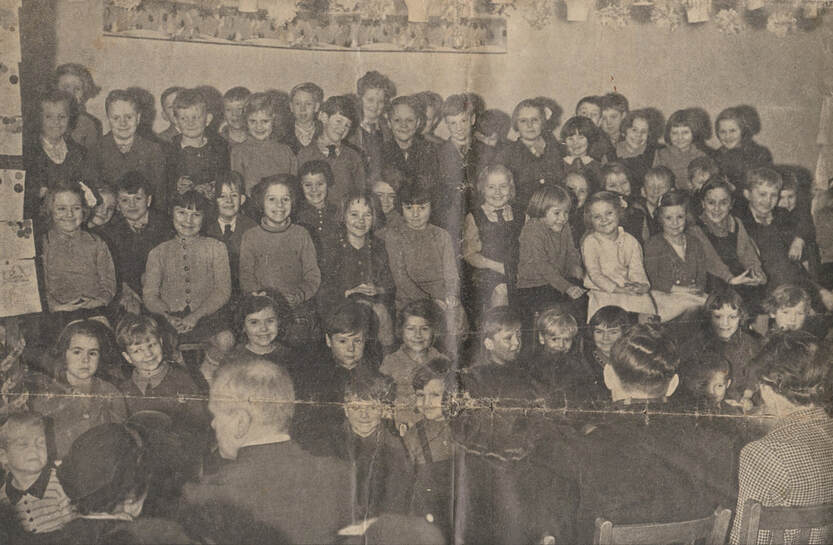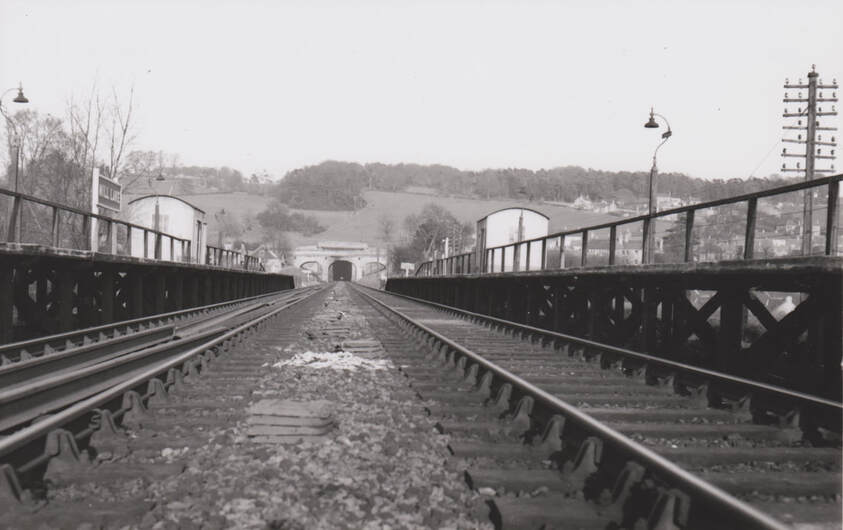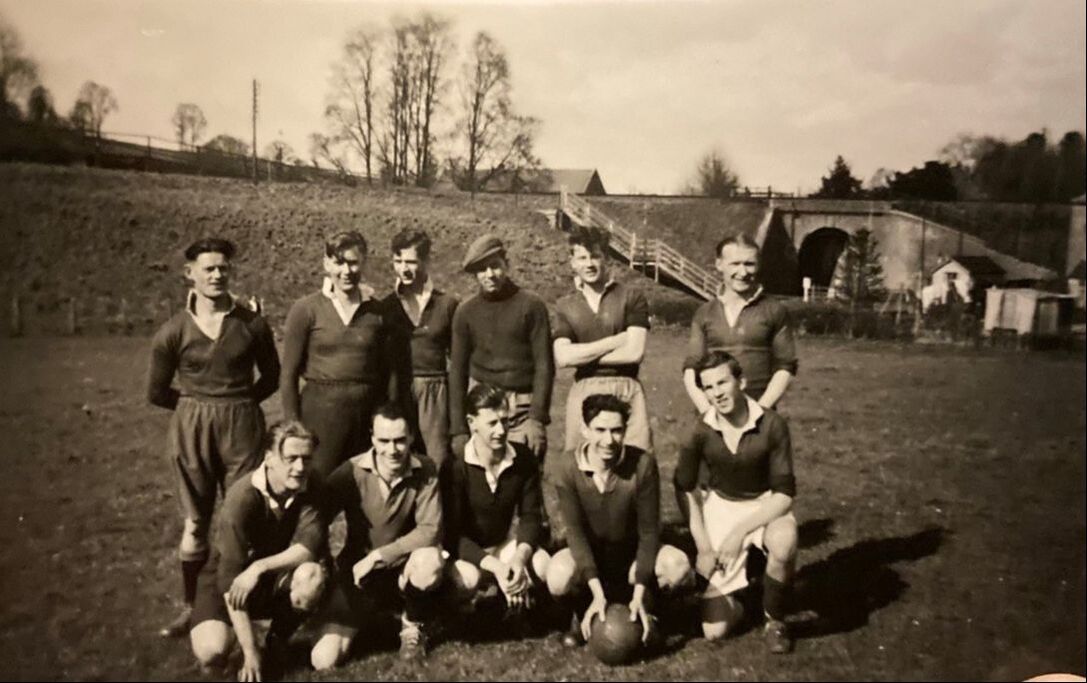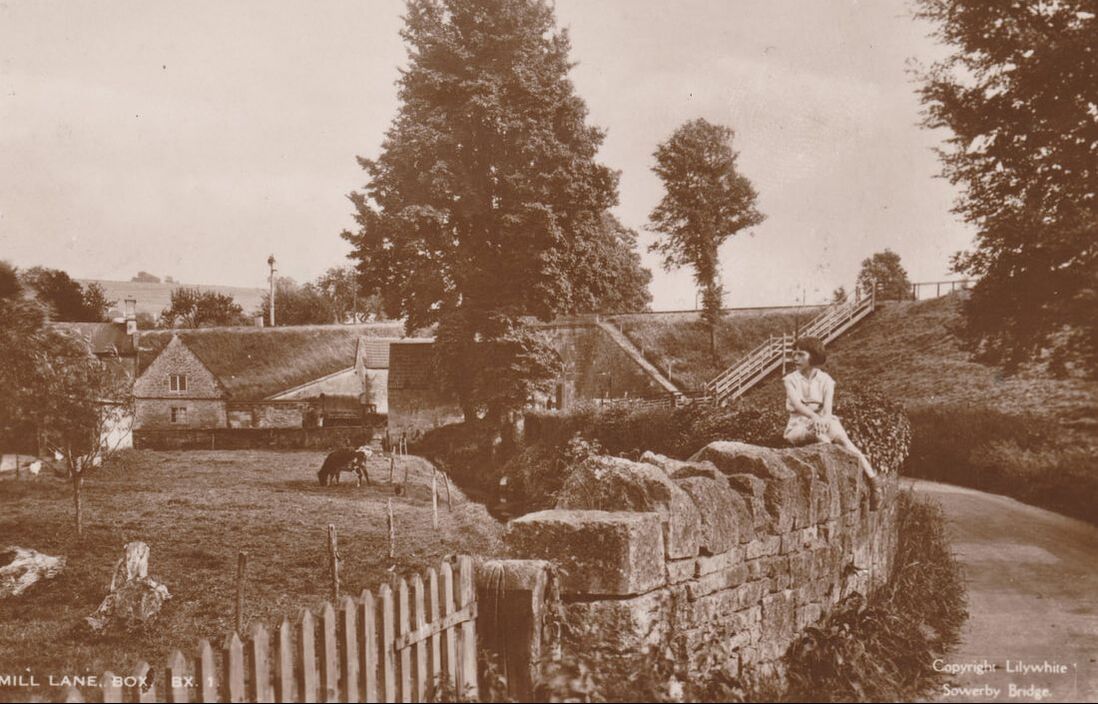Mill Lane Halt 1930 Alan Payne July 2022
Mill Lane Halt was the passenger railway access used by most people in Box village, rather than the official Box Station some distance away behind the Northey Arms. The Halt was at the foot of The Rec on the embankment where the railway bridge crossed the Mill Lane near Box Mill. Whilst it was officially a passenger-request halt (involving flagging down trains), it was used so frequently that a booking office shed was built at the foot of the platform steps and drivers regularly stopped at the Halt of their own volition on journeys from Bristol to Chippenham.
Need for the Halt
There had been a continuing trend over several decades towards concentrating residential facilities in the centre and east of Box village but the official Box Station didn't easily accommodate this need. The coming of the railways in 1841 allowed greater goods transport to Box, which became a depot for items like coal, imported building materials and domestic requisites. This helped to encourage the growth of specialist shops in the centre offering those goods for sale. But little residential development took place around the west of the village, partly because this was blocked by the Box Cemetery opened in 1858.
The development of the east side of the village started with the creation of the Box Schools in 1875 and the sale of individual plots of land for housing along the London Road. The expansion of quarrymen's houses at Box Hill was largely ignored by the GWR and property development was restricted on the south of Beech Road by the gravity-driven rail track built by Pictor & Sons to take stone from Clift Quarry Works on Box Hill down to The Wharf. As the stone trade declined after the First World War, new possibilities opened up resulting in the building of The Bassetts estate in 1929.
There had been a continuing trend over several decades towards concentrating residential facilities in the centre and east of Box village but the official Box Station didn't easily accommodate this need. The coming of the railways in 1841 allowed greater goods transport to Box, which became a depot for items like coal, imported building materials and domestic requisites. This helped to encourage the growth of specialist shops in the centre offering those goods for sale. But little residential development took place around the west of the village, partly because this was blocked by the Box Cemetery opened in 1858.
The development of the east side of the village started with the creation of the Box Schools in 1875 and the sale of individual plots of land for housing along the London Road. The expansion of quarrymen's houses at Box Hill was largely ignored by the GWR and property development was restricted on the south of Beech Road by the gravity-driven rail track built by Pictor & Sons to take stone from Clift Quarry Works on Box Hill down to The Wharf. As the stone trade declined after the First World War, new possibilities opened up resulting in the building of The Bassetts estate in 1929.
Above Left: The Wharf before it was developed into a nursing home (courtesy John Currant)
Above Right: Mill Lane Halt west of The Wharf (courtesy John Brooke Flashman). The old Clift Quarry tramway shows top right
Above Right: Mill Lane Halt west of The Wharf (courtesy John Brooke Flashman). The old Clift Quarry tramway shows top right
Local voices in favour of a central, passenger railway access point began to be heard loudly through the parish and rural district councils (established in the 1880s and 1890s) and the nationalisation of the railways during the Great War and their merger into the Big Four on 1 January 1923 brought matters to a head.
Box Mill Lane Halt, 1930
The building of Mill Lane Halt Railway Station revolutionised life in Box, making it possible for daily travel to local towns for schooling, work and leisure activities. Sometimes called Woodstock Halt, it is one of the features which resound prominently in elderly residents’ memories. When Roy Hodges moved to the newly-built Bassetts houses in 1930 he was met at the Halt by the Box policeman, wondering about the intentions of the stranger. When Stanley and Mildred Brunt set off on honeymoon in 1930, they waved goodbye to family and friends at the Halt but could only afford a single stop on the line before disembarking at the Box Railway Station at the Northey Arms to go further by motor cycle.
The Halt was a latecomer to the village and only had a short life, lasting just over thirty years. Residents had long been requesting a central station and a village petition was started by the residents of Box Hill and sent to the GWR in 1914 but was refused on the grounds of cost.[1] Mill Lane Halt was created in 1929-30 and opened on 31 March 1930. As the east of the village was developed for housing in the decades before the First World War, the need for a station in the centre of the village became more obvious.
The building of Mill Lane Halt Railway Station revolutionised life in Box, making it possible for daily travel to local towns for schooling, work and leisure activities. Sometimes called Woodstock Halt, it is one of the features which resound prominently in elderly residents’ memories. When Roy Hodges moved to the newly-built Bassetts houses in 1930 he was met at the Halt by the Box policeman, wondering about the intentions of the stranger. When Stanley and Mildred Brunt set off on honeymoon in 1930, they waved goodbye to family and friends at the Halt but could only afford a single stop on the line before disembarking at the Box Railway Station at the Northey Arms to go further by motor cycle.
The Halt was a latecomer to the village and only had a short life, lasting just over thirty years. Residents had long been requesting a central station and a village petition was started by the residents of Box Hill and sent to the GWR in 1914 but was refused on the grounds of cost.[1] Mill Lane Halt was created in 1929-30 and opened on 31 March 1930. As the east of the village was developed for housing in the decades before the First World War, the need for a station in the centre of the village became more obvious.
Box Mill Lane Halt was built at the same time as Bathford Halt which appears to be of similar construction and Oldfield Park Halt which being in a cutting was of a different construction. Bathford and Oldfield Park opened in 1929. All three halts appear to have had plain curved corrugated iron shelters rather than the famed GWR Pagoda style. (An example of GWR corrugated iron can be seen on the Beckford Road bridge over the railway at the east end of Sydney Gardens).[2] The original premises at Box was a single timber platform accessed from Mill Lane, which cost £800.[3] This was later replaced by two platforms made of concrete with corrugated iron shelters for passengers. The length of the site was limited by topography and the platforms could only accommodate four rail carriages, which necessitated passengers using the rear of the train. To give access to travellers, a small wooden ticket office with corrugated iron roof was built at the bottom of the steps to Mill Lane platform. The senior porter checked tickets and manned the office.
Impact of the Halt
Mill Lane Halt had a major impact on the development of the village, encouraging in-fill housing on the eastern side of the village, including London Road and influencing the location of The Bassets and later Bargates, both easily accessible to the railway. Some railway men lived in these locations and used the rail service from the Halt to get to work at other stations.
For many village children, it offered easy access to train spot, take photographs and even occasionally have a ride courtesy of a benevolent train driver. Seen in the photo below right are L to R: Frank Killick (son of Len Killick who ran the cobblers' shop in The Shed), Tony Green from 2 Bargates, Robin Sawyer and Philip Macdonald Currant. (Photos from the 1950s courtesy of John Currant).
Mill Lane Halt had a major impact on the development of the village, encouraging in-fill housing on the eastern side of the village, including London Road and influencing the location of The Bassets and later Bargates, both easily accessible to the railway. Some railway men lived in these locations and used the rail service from the Halt to get to work at other stations.
For many village children, it offered easy access to train spot, take photographs and even occasionally have a ride courtesy of a benevolent train driver. Seen in the photo below right are L to R: Frank Killick (son of Len Killick who ran the cobblers' shop in The Shed), Tony Green from 2 Bargates, Robin Sawyer and Philip Macdonald Currant. (Photos from the 1950s courtesy of John Currant).
The main impact of the Halt was on the residential estates at Rudloe and Box Hill. The downhill walk to the Halt was pleasantly comfortable to put pedestrians within easy range of the railway, saving some two miles trudge to the main station with the normal facilities at the Northey Arms. It helped to make the easterly areas the popular residential locations that they now are. We can see this when a footpath was claimed to exist in 1938 from Grove Farm: It was pointed out that the making of the Mill Lane Railway Halt had rendered the path of increased importance.[4]
Perhaps the most notable event in the history of Mill Lane Halt was in the very last days of the inter-war years in September 1939 when thousands of London schoolchildren were evacuated to the West Country. The main line express train which brought them made a historic stop at Mill Lane Halt (one of the few such occasions) to allow the 96 Box evacuees to disembark directly in the village. It was a small contribution towards the planning of security for young people in the war. Pat Coles recalled going to the 1951 Festival of Britain with a group from Box Highland School, which also boarded an express train at Box Mill Lane.
The photos above and below record the demise of Mill Lane Halt. For residents it was the end of a national era when the railways came to the centre of the village to link the area to the rest of Britain for people of all social levels. Above are the platforms used by residents and below are the steps leading up to them from the south side near Box Rec (below left courtesy Len Shewring) and from the north side by Box Mill (below right courtesy John Currant).
The Halt was closed on 4 January 1965 as part of the Beeching cuts, the platforms removed and the steps dismantled. Local residents opposed the closure of Box Station for 12 months but the end came to all stations on the Swindon to Temple Meads What a tragedy!
References
[1] The Bath Chronicle, 25 July 1914
[2] Courtesy Robert Coles
[3] Colin G Maggs, The GWR Swindon to Bath Line, p. 80
[4] The Wiltshire Times, 5 January 1935
[1] The Bath Chronicle, 25 July 1914
[2] Courtesy Robert Coles
[3] Colin G Maggs, The GWR Swindon to Bath Line, p. 80
[4] The Wiltshire Times, 5 January 1935
